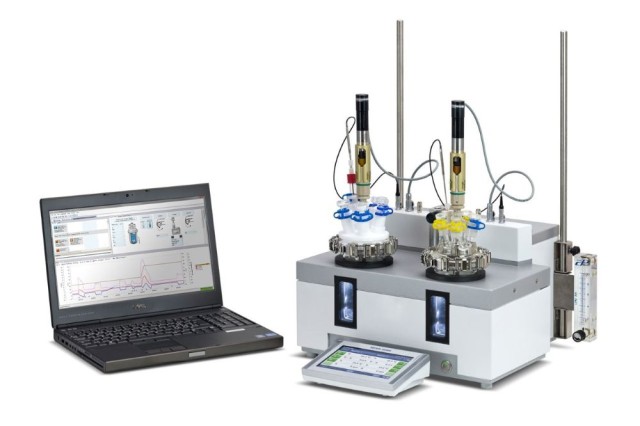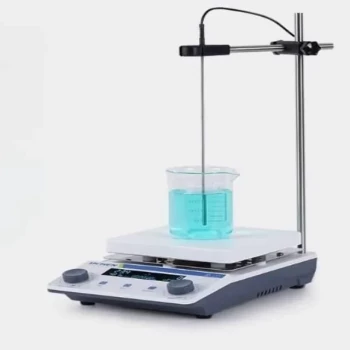مفاعلات الضغط العالي
التطبيقات
تعد المفاعلات عالية الضغط أدوات لا غنى عنها في مجال البحوث الكيميائية، خاصة عند التعامل مع الظروف القاسية. وقد صُممت هذه المفاعلات المتخصصة بدقة لتتحمل وتسهل التفاعلات الكيميائية ذات درجات الحرارة العالية والضغط العالي، مما يجعلها مثالية للتعامل مع المواد التي تشكل مخاطر كبيرة.
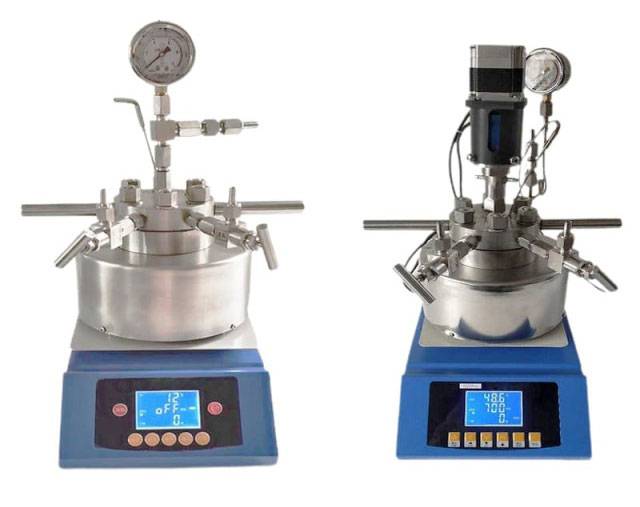
على وجه التحديد، تعتبر المفاعلات عالية الضغط ضرورية للتجارب التي تنطوي على وسائط قابلة للاشتعال والانفجار والسامة. ويضمن بناؤها القوي السلامة والكفاءة، مما يسمح للباحثين بالتعامل مع هذه المواد الخطرة دون المساس بسلامة التجارب. هذه القدرة ذات قيمة خاصة في صناعات مثل البتروكيماويات والمستحضرات الصيدلانية والمواد الكيميائية المتخصصة، حيث تكون الحاجة إلى التحكم الدقيق في ظروف التفاعل أمرًا بالغ الأهمية.
وعلاوة على ذلك، تمتد براعة المفاعلات عالية الضغط إلى ما هو أبعد من السلامة. فهي مجهزة للتعامل مع مجموعة واسعة من العمليات الكيميائية، من البسيطة إلى المعقدة، مما يتيح مجموعة واسعة من التطبيقات. وسواء كان الأمر يتعلق بتوليف مركبات جديدة، أو تحسين مسارات التفاعل، أو دراسة حركية التفاعل، فإن المفاعلات عالية الضغط توفر البيئة اللازمة لتحقيق النتائج المرجوة.
وباختصار، المفاعلات عالية الضغط ليست مجرد أدوات، بل هي مكونات أساسية في تطوير البحوث الكيميائية والعمليات الصناعية، حيث توفر السلامة والوظائف في أكثر البيئات صعوبة.
المفاعلات الزجاجية
الوظائف
تم تصميم المفاعلات الزجاجية بهيكل زجاجي مزدوج الطبقات، وهو أمر بالغ الأهمية للتعامل مع مجموعة متنوعة من مواد التفاعل. يسمح هذا التصميم الفريد من نوعه بالتشغيل متعدد الاستخدامات، بما في ذلك التقليب في ظروف الضغط العادي والسلبي. لا يوفر الزجاج مزدوج الطبقة الشفافية لمراقبة التفاعلات فحسب، بل يضمن أيضًا بيئة مستقرة من خلال تسهيل التحكم في درجة الحرارة الثابتة. ويتحقق ذلك من خلال دمج أنظمة التدفئة والتبريد، والتي يمكن أن تحافظ على تنظيم دقيق لدرجة الحرارة طوال عملية التفاعل.
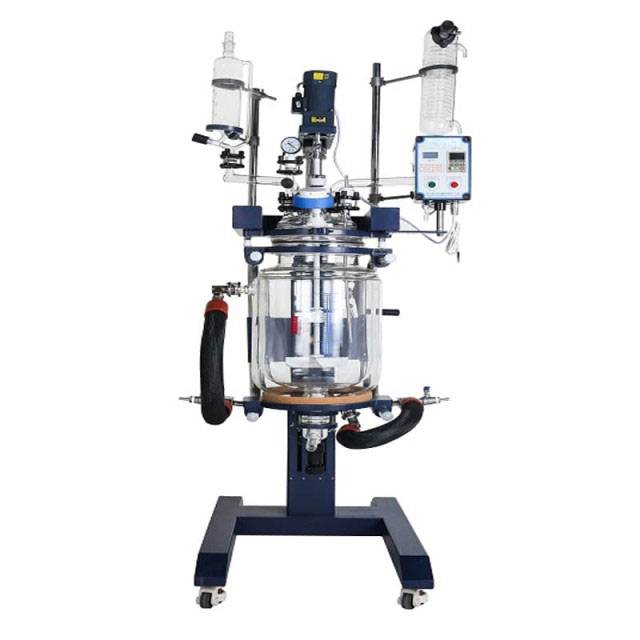
بالإضافة إلى التحكم في درجة الحرارة، يوفر الهيكل الزجاجي مزدوج الطبقة ميزات سلامة معززة. تعمل الطبقة الخارجية من الزجاج كحاجز وقائي، مما يقلل من خطر التعرض العرضي للمواد الخطرة. ويعد هذا التصميم مفيدًا بشكل خاص عند التعامل مع المركبات الحساسة أو المتطايرة، لأنه يقلل من احتمال حدوث تسربات وانسكابات.
وتتجاوز وظائف المفاعلات الزجاجية التحريك الأساسي والتحكم في درجة الحرارة. فهي مجهزة أيضًا بميزات متقدمة مثل تنظيم الضغط الآلي وأنظمة التحكم القابلة للبرمجة. وتتيح هذه الميزات للباحثين إجراء تفاعلات معقدة بدقة عالية وقابلية للتكرار، مما يجعل المفاعلات الزجاجية أداة لا غنى عنها في المختبرات الحديثة.
المفاعلات المغناطيسية
آلية الختم
تستخدم المفاعلات المغناطيسية هيكل ختم ثابت متطور يدمج مقرنة مغناطيسية. هذا التصميم محوري في التخفيف من مشاكل التسرب، وبالتالي ضمان بيئة عمل محكمة الغلق تمامًا. تعمل المقرنة المغناطيسية كجهاز نقل بدون تلامس، مما يسهل نقل عزم الدوران والحركة بدون تلامس مادي مباشر. وتعد هذه الميزة مفيدة بشكل خاص في التعامل مع المواد الخطرة، حيث يمكن حتى للتسريبات الدقيقة أن تعرض سلامة التجارب وسلامتها للخطر.
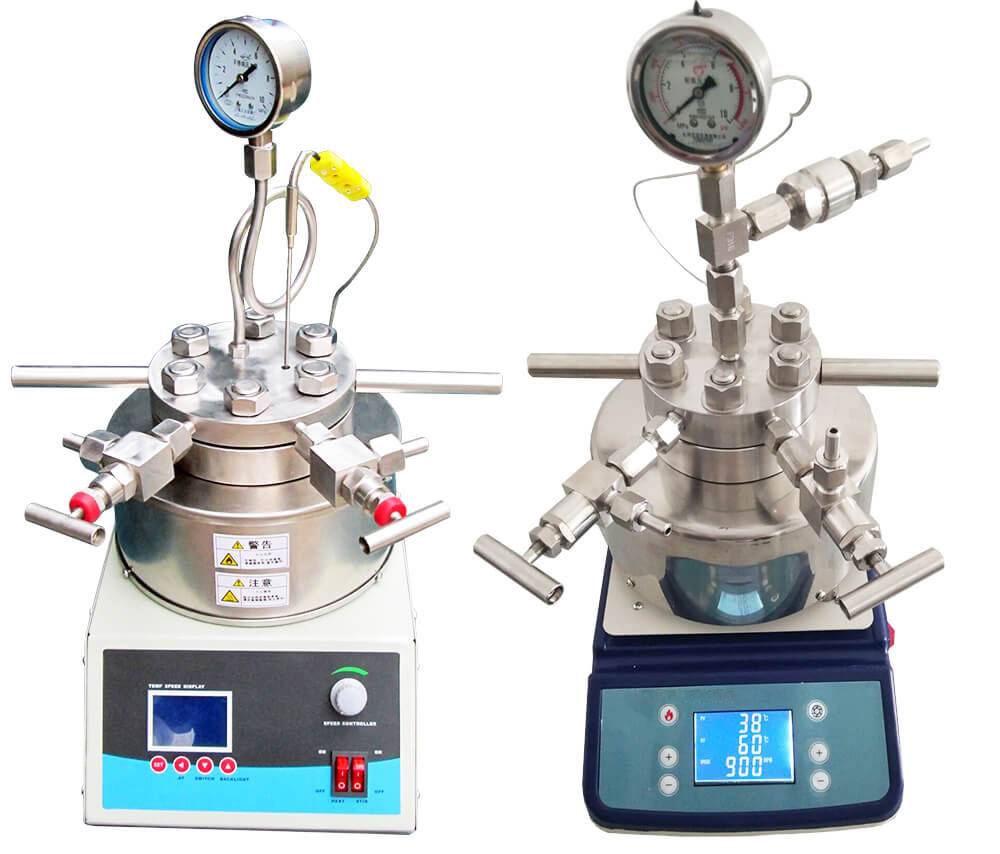
تعمل آلية الختم الساكن على مبدأ المجالات المغناطيسية، التي تتفاعل مع المكونات الداخلية للمفاعل لتمكين التشغيل السلس دون الحاجة إلى موانع تسرب ميكانيكية. وهذا النهج لا يعزز متانة المفاعل فحسب، بل يبسط أيضاً إجراءات الصيانة. ومن خلال الاستغناء عن الحاجة إلى الاستبدال المتكرر لموانع التسرب المتكررة، تنخفض التكلفة التشغيلية الإجمالية، مما يجعل المفاعلات المغناطيسية خيارًا فعالًا من حيث التكلفة للمختبرات.
وعلاوة على ذلك، يضمن الختم الكامل بقاء بيئة التفاعل نقية وخالية من الملوثات الخارجية التي يمكن أن تغير نتائج التفاعل. ويعد هذا المستوى من التحكم البيئي أمرًا بالغ الأهمية للتجارب التي تتطلب ظروفًا دقيقة، مثل تلك التي تنطوي على وسائط سامة أو قابلة للانفجار. وتؤكد كفاءة المقرن المغناطيسي في الحفاظ على بيئة محكمة الإغلاق على ملاءمة المفاعل لأنشطة البحث والتطوير عالية المخاطر.
أجهزة التوليف بالموجات الدقيقة
التفاعلات التحفيزية
تلعب أجهزة التخليق بالموجات الدقيقة دورًا أساسيًا في تحفيز مجموعة واسعة من التفاعلات في مختلف المجالات، بما في ذلك الكيمياء العضوية والمستحضرات الصيدلانية والكيمياء الحيوية. تستفيد هذه المُركّبات من الخصائص الفريدة للموجات الدقيقة لتعزيز معدلات التفاعل والإنتاجية، مما يجعلها أدوات لا غنى عنها في المختبرات الحديثة.
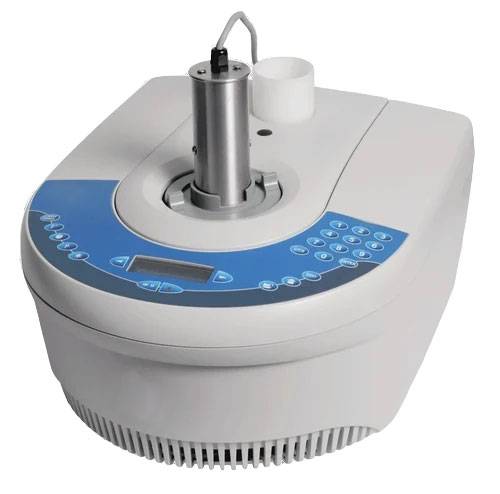
تتمثل إحدى المزايا الرئيسية لأجهزة التوليف بالموجات الدقيقة في قدرتها على تسهيل التفاعلات العضوية المعقدة. وغالباً ما تتطلب هذه التفاعلات تحكماً دقيقاً في درجة الحرارة والضغط، وهي ظروف يمكن أن توفرها الموجات الدقيقة بكفاءة. على سبيل المثال، غالبًا ما ينطوي تخليق المستحضرات الصيدلانية على تحولات جزيئية معقدة تستفيد من التسخين السريع والموحد الذي توفره الموجات الدقيقة.
وفي مجال الكيمياء الحيوية، تُستخدم أجهزة التوليف بالموجات الدقيقة لتحفيز التفاعلات التي تنطوي على جزيئات حيوية. يمكن أن تكون هذه التفاعلات صعبة بشكل خاص بسبب حساسية المواد البيولوجية للحرارة والعوامل البيئية الأخرى. تساعد التسخين المتحكم فيه وأوقات التفاعل السريعة التي توفرها الموجات الدقيقة على تقليل التدهور وزيادة نقاء المنتج إلى الحد الأدنى.
وبالإضافة إلى التفاعلات الكيميائية، تؤدي أجهزة التوليف بالموجات الدقيقة أيضًا دورًا حاسمًا في العمليات الفيزيائية مثل الاستخلاص بالمذيبات. تُستخدم هذه التقنية على نطاق واسع في استخلاص المركبات القيمة من المخاليط المعقدة، وهي عملية يمكن تسريعها وتحسينها بشكل كبير باستخدام طاقة الموجات الدقيقة.
باختصار، تعد أجهزة التوليف بالموجات الصغرية أدوات متعددة الاستخدامات توسع من قدراتها التحفيزية عبر مجموعة من التخصصات العلمية، مما يعزز كفاءة وفعالية البحث والتطوير في المختبرات.
مسعرات التفاعل
القياس
مسعرات التفاعل هي أدوات لا غنى عنها في المختبر، وهي مصممة لقياس الحرارة المنطلقة أو الممتصة أثناء التفاعلات الكيميائية أو العمليات الفيزيائية. يعد هذا القياس أمرًا بالغ الأهمية لاكتساب رؤى في مجال الكيمياء الحرارية والحركية، وهي ضرورية لفهم تغيرات الطاقة ومعدلات التفاعل التي تنطوي عليها العمليات المختلفة.
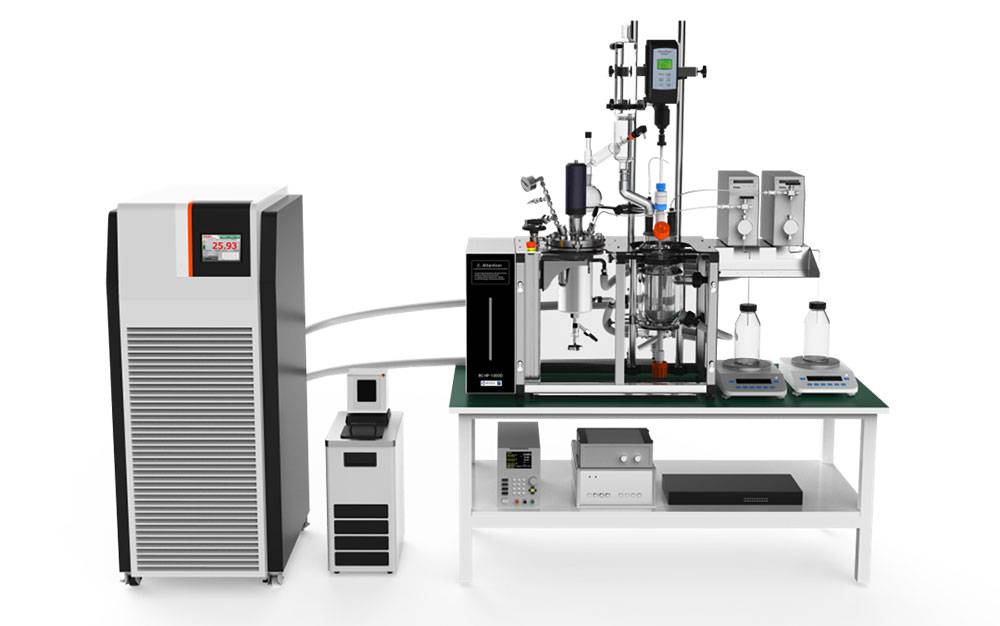
يمكن استخدام البيانات التي يتم جمعها من مسعرات التفاعل لتحليل الخصائص الديناميكية الحرارية للتفاعلات، مثل تغيرات الإنثالبي والانتروبي، والتي تعتبر أساسية للتنبؤ بنتائج التفاعل وتحسين ظروف التفاعل. وبالإضافة إلى ذلك، توفر المعلمات الحركية المستمدة من هذه القياسات، مثل طاقة التنشيط وترتيب التفاعل، معلومات قيمة للتحكم في العملية وتوسيع نطاقها.
| معلمة القياس | رؤية الكيمياء الحرارية | رؤية الحركية |
|---|---|---|
| إطلاق/امتصاص الحرارة | تغير الإنثالبي | معدل التفاعل |
| تغير درجة الحرارة | تغير الإنتروبي | طاقة التنشيط |
من خلال مراقبة التدفق الحراري، يمكن للباحثين أيضًا تحديد المخاطر المحتملة، مثل التفاعلات الطاردة للحرارة التي يمكن أن تؤدي إلى تفاعلات هاربة أو ارتفاع درجة الحرارة، وبالتالي ضمان ممارسات مختبرية أكثر أمانًا. إن تكامل بيانات المسعرات الحرارية مع التقنيات التحليلية الأخرى يعزز الفهم الشامل لأنظمة التفاعل المعقدة، مما يجعل مسعرات التفاعل مكونًا أساسيًا في البحث والتطوير الكيميائي الحديث.
أجهزة تقييم المحفزات
مبادئ التقييم
تحاكي أجهزة تقييم المحفزات ظروف التفاعل في العالم الحقيقي لتقييم كفاءة المحفزات. ويعتمد هذا التقييم في المقام الأول على المقاييس المستمدة من نواتج التفاعل، والتي يتم تحليلها بدقة لقياس فعالية المحفز. يتم تصنيف طرق التقييم هذه بشكل عام إلى نوعين: ثابت وديناميكي.

التقييم الثابت يتضمن إعداد بيئة محكومة حيث تظل ظروف التفاعل ثابتة طوال فترة التجربة. هذه الطريقة مفيدة بشكل خاص لدراسة النشاط الأولي وانتقائية المحفزات في ظل ظروف مستقرة. يتم تثبيت المعلمات الرئيسية مثل درجة الحرارة والضغط وتركيزات المواد المتفاعلة، مما يسمح بإجراء تحليل مفصل لأداء المحفز دون تدخل المتغيرات المتقلبة.
التقييم الديناميكي ، من ناحية أخرى، يحاكي إعدادات صناعية أكثر واقعية حيث تخضع ظروف التفاعل للتغيير. يقيّم هذا النهج مدى قدرة المحفز على الحفاظ على كفاءته في ظل ظروف متغيرة، مثل تقلب درجات الحرارة أو تغير تركيزات المواد المتفاعلة. يعد التقييم الديناميكي أمرًا بالغ الأهمية للتنبؤ بأداء واستقرار المحفزات على المدى الطويل في العمليات المستمرة، مما يوفر رؤى لا يمكن للتقييم الثابت وحده تقديمها.
| نوع التقييم | الميزات الرئيسية | التطبيق |
|---|---|---|
| ثابت | ظروف ثابتة ومضبوطة | دراسات النشاط الأولي والانتقائية |
| ديناميكية | الظروف المتغيرة | الأداء طويل الأجل والاستقرار في العمليات المستمرة |
تُعد كل من طرق التقييم الثابتة والديناميكية ضرورية لإجراء تقييم شامل لكفاءة المحفز، مما يضمن تحسين المحفز المختار لظروف التفاعل المحددة التي سيواجهها في التطبيقات العملية.
محطات عمل التخليق
الأتمتة
تُحدث المفاعلات التوليفية المؤتمتة بالكامل، التي يتم التحكم فيها بواسطة أنظمة كمبيوتر متقدمة، ثورة في مجال أبحاث المركبات والأدوية. وتتعامل هذه الآلات المتطورة مع عدد لا يحصى من العمليات بدقة وكفاءة، بما في ذلك التغذية والتسخين والتقليب والتقطير. لا تعزز الأتمتة من إمكانية تكرار التجارب ودقتها فحسب، بل تقلل أيضًا من مخاطر الخطأ البشري، وهو أمر بالغ الأهمية بشكل خاص في البيئات البحثية الحساسة وعالية المخاطر.

تتمثل إحدى المزايا الرئيسية لهذه الأنظمة المؤتمتة في قدرتها على إدارة تسلسل العمليات المعقدة دون تدخل يدوي. هذه القدرة مفيدة بشكل خاص في تركيب المركبات المعقدة حيث يمكن أن يؤدي أدنى انحراف إلى اختلافات كبيرة في المنتج النهائي. تضمن الأنظمة التي يتم التحكم فيها بالكمبيوتر تنفيذ كل خطوة باستخدام المعلمات الدقيقة المحددة مسبقًا من قبل الباحثين، وبالتالي الحفاظ على الاتساق عبر عمليات متعددة.
وعلاوة على ذلك، تسمح الأتمتة بالتشغيل المستمر، مما يمكن أن يسرّع عملية البحث بشكل كبير. يمكن للباحثين إعداد التجارب لتشغيلها طوال الليل أو خلال عطلات نهاية الأسبوع، مما يزيد من الاستفادة من وقت المختبر. ويتم تسهيل هذا التشغيل المستمر من خلال التصميم القوي للمفاعلات، والتي تم تصميمها لتتحمل فترات طويلة من الاستخدام دون المساس بالأداء.
بالإضافة إلى فوائدها التشغيلية، تساهم مفاعلات التخليق المؤتمتة أيضًا في السلامة في المختبر. من خلال التعامل مع العمليات الخطرة مثل التسخين والتقطير، تقلل هذه الأنظمة من تعرض الباحثين للمواد الكيميائية والظروف التي يحتمل أن تكون خطرة. وهذا لا يحمي صحة وسلامة فريق البحث فحسب، بل يضمن أيضًا الامتثال للوائح السلامة المختبرية الصارمة.
كما يتيح تكامل التحكم بالكمبيوتر أيضًا إمكانية المراقبة في الوقت الفعلي وتسجيل البيانات، مما يوفر للباحثين رؤى قيمة حول ديناميكيات التفاعل. ويمكن استخدام هذه البيانات لتحسين ظروف التفاعل، وتحديد أوجه القصور، وتحسين عملية التوليف. تعد القدرة على التحليل والتعديل في الوقت الفعلي تقدمًا كبيرًا يمكن أن يؤدي إلى نتائج بحثية أكثر كفاءة وفعالية.
باختصار، يمثل ظهور مفاعلات التوليف المؤتمتة بالكامل تحولًا محوريًا في طريقة إجراء أبحاث المركبات والأدوية. ومن خلال الاستفادة من الدقة التي يتم التحكم فيها بالكمبيوتر، تعمل هذه الأنظمة على تعزيز قابلية التكرار، وتسريع الجداول الزمنية للأبحاث، وتحسين السلامة، وتوفير بيانات قيمة لتحسين العملية. ومع استمرار تطور هذه التكنولوجيا، من المتوقع أن يتزايد تأثيرها على مجال التخليق الكيميائي، مما يمهد الطريق لاكتشافات وابتكارات جديدة.
المنتجات ذات الصلة
- مفاعل مفاعل ضغط عالي من الفولاذ المقاوم للصدأ للمختبر
- مفاعل أوتوكلاف صغير من الفولاذ المقاوم للصدأ عالي الضغط للاستخدام المخبري
- مفاعلات الضغط العالي القابلة للتخصيص للتطبيقات العلمية والصناعية المتقدمة
- مفاعل الأوتوكلاف عالي الضغط للمختبرات للتخليق المائي الحراري
- خلاط مغناطيسي صغير ثابت درجة الحرارة ومسخن ومحرك للمختبر
